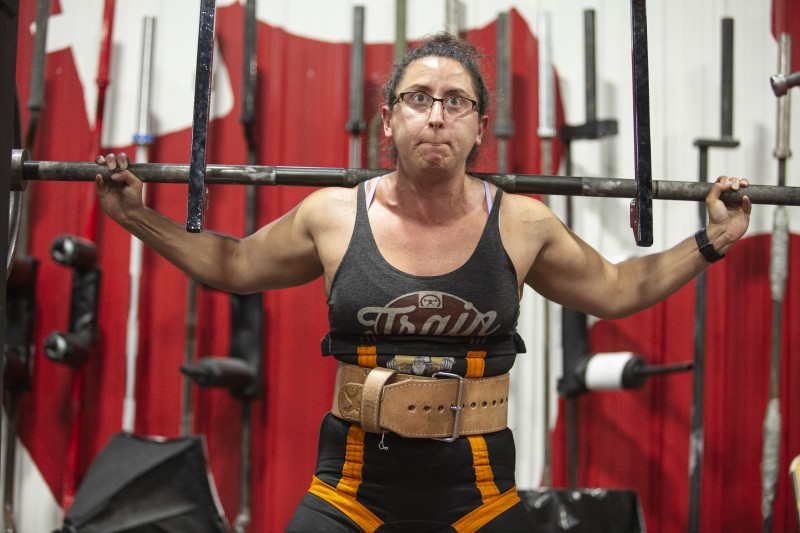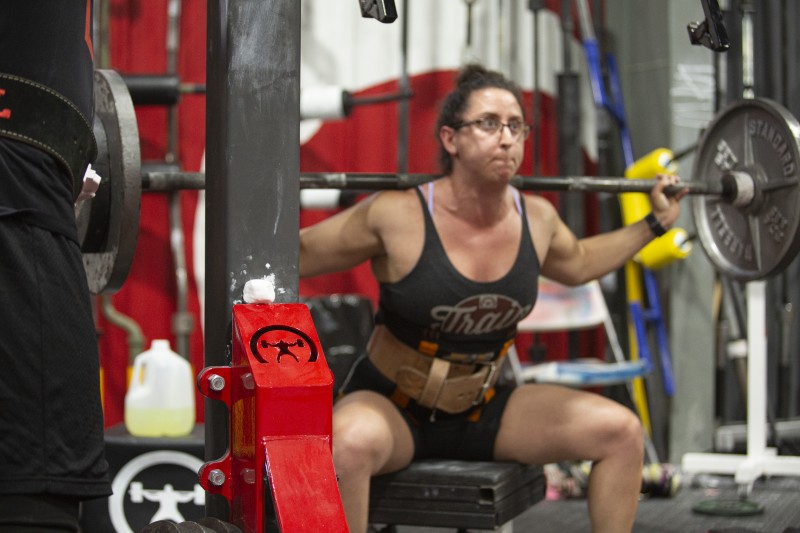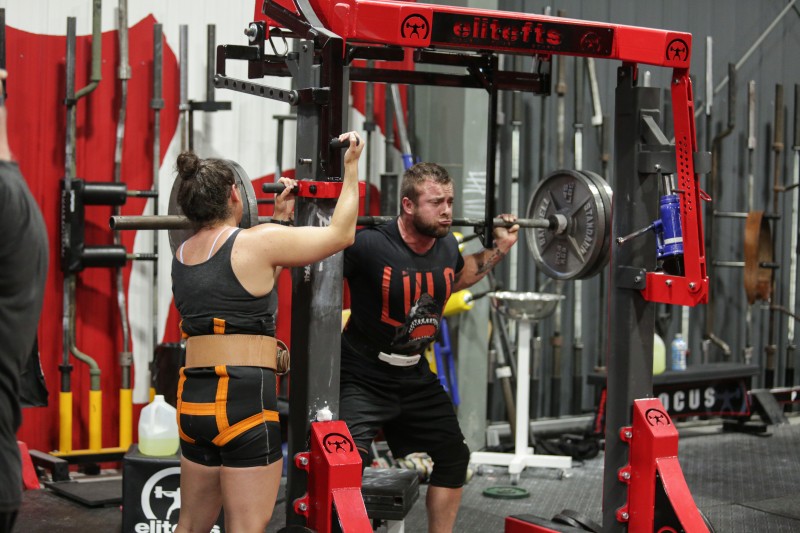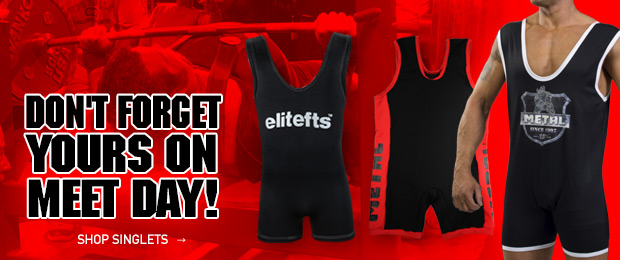
I consider the last four years I’ve been training at elitefts to be when I went from a beginner to an intermediate lifter. I’ve been training for longer but not with any substantial knowledge about what I was doing. The last four years are really when I learned how to train myself and how to help others (THANKS, DAVID TATE).
But what does it mean to be an intermediate lifter? It’s definitely not just your numbers and lifting experience. It’s also how you approach training — your focus and decision making need to evolve. I’ve been thinking about the biggest changes in my lifting over the past few years, and some of the most important changes had nothing to do with my technique or program but with my overall approach to training.
MEET REPORT: Taking Third Place at APF Women's Pro-Am
1. The big picture or the little picture?
For many years, I focused on all the little decisions that I thought would make my training better: How many sets should I do on this exercise? Is this the right weight? Should I take that set again? Am I choosing the right handle for lat pulls (yes, this is a real thought)?
But you know what? At a certain point, those little choices aren’t all that important. If you train hard and follow a semi-decent program, you will be on the right track.
I realized that the bigger picture decisions I made had more of an effect on my training than the minute training decisions I mulled over on a regular basis.
So, what have I been doing differently? I finally put more focus on maximizing my recovery time outside of the gym. I know it’s been said a million times, and you probably think, “Yeah I focus on my recovery outside of the gym” but do you really? I thought I had been until I made these changes in the past meet cycle and actually noticed a surprising difference in my training and meet performance. At a certain point, putting your attention and effort into the bigger picture will yield a bigger return than just focusing on the time you spend in the gym.

Here is what I changed this past meet cycle:
- I fucking slept enough! I always knew I needed a lot of sleep. Eight or more hours are what I need to not be a useless sack of flesh for a day. And I thought I slept that much. But I got a Fitbit to see if I actually was sleeping enough, and lo and behold! I wasn’t. I actually sleep an hour less than I thought every night since I am apparently awake for at least an hour every night doing God knows what. So my last training cycle, I made it a priority to get into bed earlier to account for that extra awake time. I used to just make sure I slept extra on the nights before I trained so I would feel good for training but this time, I put the emphasis on sleeping more than enough the nights after I trained so I could get my recovery sleep. I literally just imagine myself getting stronger because I am sleeping and that is impetus enough for me to get into bed an hour earlier.
- I ate enough. Jeez, this all sounds so basic, but I thought I had been doing these things for years and I had not. I know that I suck at cooking, and if left up to my own devices, I will get bored of ground beef and a random carb. Each meet cycle, I always tell myself I will do some meal prep and eat enough, and it’s easy and blah, blah, blah. But I don’t. I track my macros for a while, but then, when I stop, I definitely slack. So instead of deluding myself yet again, I bit the bullet and got meal delivery. About five meals a week to supplement my ground beef extravaganza and breakfast and snacks. I got high calorie, high protein meals that I would actually eat. And lo and behold, I actually put on the most muscle I ever have during a meet cycle. I got shoulders for the first time! I gained weight! I got stronger! Thanks, food.
- I got my mental shit together. I wrote a lot about this in a log (link here). Since I started competing, one of the biggest issues holding me back was my willingness to mentally sabotage myself by getting all worked up about meets. I changed the way I thought about competing and as a result, went into the meet feeling good, relaxed, and not crazy on meet day. As a result, I had what was probably my best meet to date. Identify what is mentally holding you back and work toward fixing it. It took me many years to do and many different approaches but once I found what worked, everything changed.
- I kept my nagging issues in check. Between my back and my elbows, I know these are just issues that will keep coming up and the most I can do is keep them from getting too bad. The goal is to be as un-fucked up as possible going into a meet. So I routinely went to the professionals at Hybrid Performance who made me feel way better than past training cycles. I went from not being able to bench off my chest during meet cycles to only having to make minor training changes to avoid significant elbow issues. I also made training decisions with the end goal of feeling good-ish going into the meet. The goal was not to follow my training to a T and crush everything I had on tap. If that means substituting exercises if something felt like shit or throwing a shoulder saver on the bar to save my elbows for my next shirted session, I did it. I made the right choices for the end goal, not the wrong choices for short-term satisfaction.
2. Reining it in
When I first started training at elitefts, I had to learn how to train hard. I had to learn to perform my supplemental and accessory movements with the same fervor and intensity that I approached my max effort movements with. I think that unless you come from an athletic or competitive background, training with intensity is a learned skill — and that’s fine.
RELATED: Powerlifting Takes More Than Just Brute Strength
However, I’m now at a point where I have to learn how to dial it back. For a while, I would go too hard. I would take that questionable extra jump that I would fail. I would do too many accessory exercises because I wanted to train every part of my upper or lower body. I would overestimate my weight and fuck up my percentages. I would want to beat anyone I was training with to the point where I would make shitty decisions. I think that’s pretty common when you want to be good and you want to push and do everything you can to get better.

But at a certain point, that mentality will actually hold you back. Dave tried to hammer it into me for a while that I didn’t need to go balls to the wall all the time. That making shitty choices in max effort jumps doesn’t make me better in the long run; it only hampers my recovery. The point is to do the least amount that you NEED TO DO to get better. Not the most you CAN do just because you want to.
My goal now is to make smart decisions. The goal is not just to push the most amount of weight that I can on a given movement. The goal is to do what I need to do to get stronger in the long run and keep myself in one piece for as long as possible.
I’m trying to learn how to rein myself in and not take that next jump that I will fail at. I’m trying to learn how to cut back on my accessory work when I’m not recovering well enough. I’m trying to learn how to dial it back when I need to — all with the goal of being stronger when it counts.
3. What is the end goal?
On the heels of making the right choices for myself is making the right choices for other lifters. My decision making for myself and other lifters is based on the answer to the question: “What is the goal?”
When I train with my peeps at elitefts, I always think of their training in terms of:
- What is the goal for the day or short-term training goal? And;
- What is the end goal?
It’s a mix of how are they feeling that day and what are they supposed to be doing? And what are their goals that this training is building toward?
I started noticing my decision-making process when I was helping another lifter who I have never trained with. They were getting ready for a meet and were squatting against bands. They did a set and asked me what they should take for their next jump. Instead of just telling them what they should take based on how the last one looked, I asked what their goal was for that day and what their training was like for the next few weeks.
They wanted to end that session with a weight that was heavier at the top than their opener at their previous meet. And the next week they needed to go even heavier, so that made the decision easy: Take a 30- to 40-pound jump to put them at a heavy double and hit what they wanted to hit for that day and shut it down there to leave room for what they wanted to hit next week.
READ MORE: How Many Times A Day Do You Train?
Had this been two years ago I would have just said, “Yeah, looks good keep going” (or something to that degree).
When I’m training with the people I train with on a regular basis and know more about their lifting, I don’t just think about what they can do to lift the most weight in that session. I think about their weak points and what they need to be working on from a technical aspect. If they want to make a change to what they are doing — is that beneficial for them just for today? Do they want to be better just in this workout or do they want to be better long-term?

Here is another MEE (Max Effort Example): The longer I train with people, the more I know about how their attempts will go before they happen. We have people who can grind through multiple heavy jumps and people whose form goes to shit once they get to heavy set. It’s not because they aren’t strong, it’s just that they lack the experience of working on their technique under heavy loads to the point where it is ingrained. Once they get to those heavy sets, I know they can only push it so much and on the next jump, their form will suffer and they will get stapled.
Watching and learning the habits and technique of my training partners helps me help them take the right jumps and make smarter calls when it comes to their heavy training. The point of max effort work is to strain under a heavy load with as little technical breakdown as possible and for each lifter, that means something different.
As a training partner, my job is to help them figure out how to get the most out of each session.
4. Hurt versus beat up
Hurt is when you are injured and actually can’t do something. Beat up is when you need to work around or push through things. Nagging issues and feeling run down from training are beat up. Having an injury that gets worse and worse with use is being hurt. One you can make it through, trying to make it through the other will impede your progress significantly.
It took me a while to learn the difference. When I hurt my back, it was injured. But I wanted to think it was just beat up. So I did the movements I shouldn’t have been doing and made it worse. It definitely took longer to recover because I didn’t take the time to recover and fix it initially.
By the time it started to get better, I would know if I were on the right track if certain movements did not lay me out. I could have avoided this by actually taking the time to figure out what the issue was, avoiding movements that made it worse and taken it a little easy. You’re not a pussy if you fix what’s wrong with you. You’re dumb for making yourself worse down the line by not taking care of it.
Find a professional to help you. You are not going to Google your problem and find the correct answer; if you do that, you are going to find the answer you want to hear. I wish I sought out the help of a professional initially instead of trying to fix it myself.
WATCH: Joe Sullivan Demonstrates Crocodile Breathing
On the flip side, you don’t want to pull back too much just because you are beat up. You may need to rein it in a bit or work around your nagging issues, but that doesn’t mean you pull out of your meet or stop doing what you need to do. It may mean you have to put extra effort into your recovery but being beat up is just a part of training hard. You just have to work to keep it from getting too bad.
My elbows are beat up. I have to make my training decisions based on what will keep them feeling the best (aka the least bad). I know they get worse going into meets but that in no way means that I shouldn’t bench or shouldn’t do a meet. I just have to maximize my recovery and prioritize movements that don’t mess them up more. I have to learn how to make adjustments on the go with the main goal of not making them hurt more.
Both involve making smart decisions. The more you want to train, the more likely you are to ignore your body and do whatever you want. Don’t. Think about what it takes to be a good lifter long-term.











10 Comments